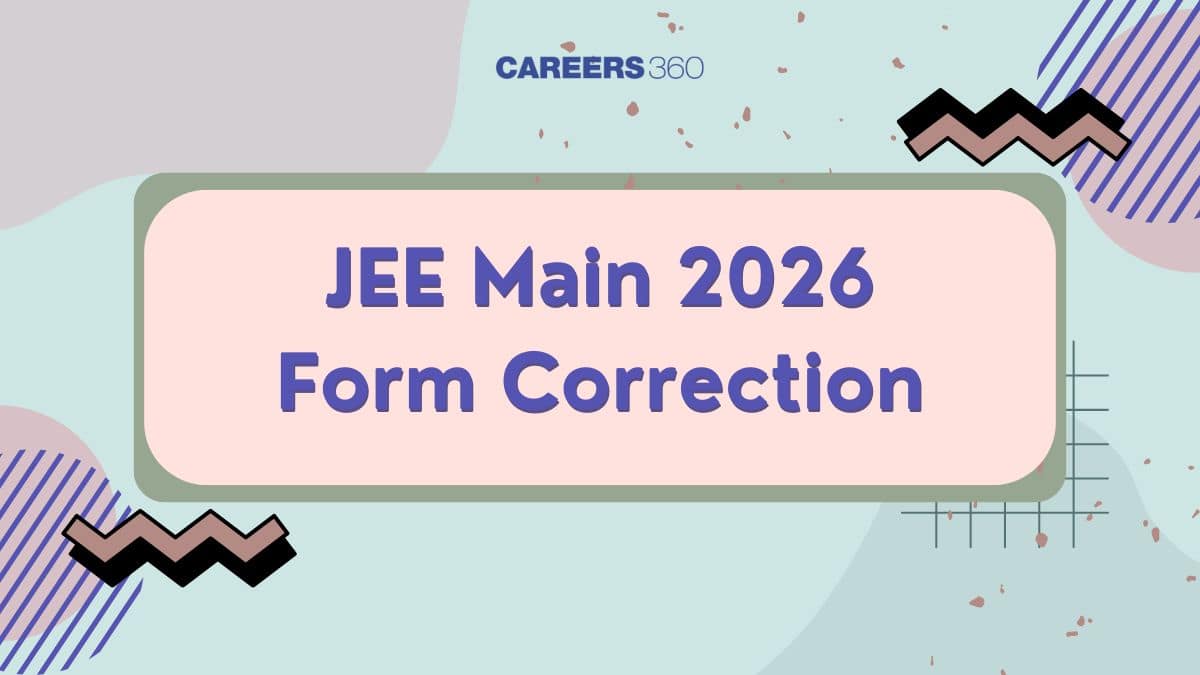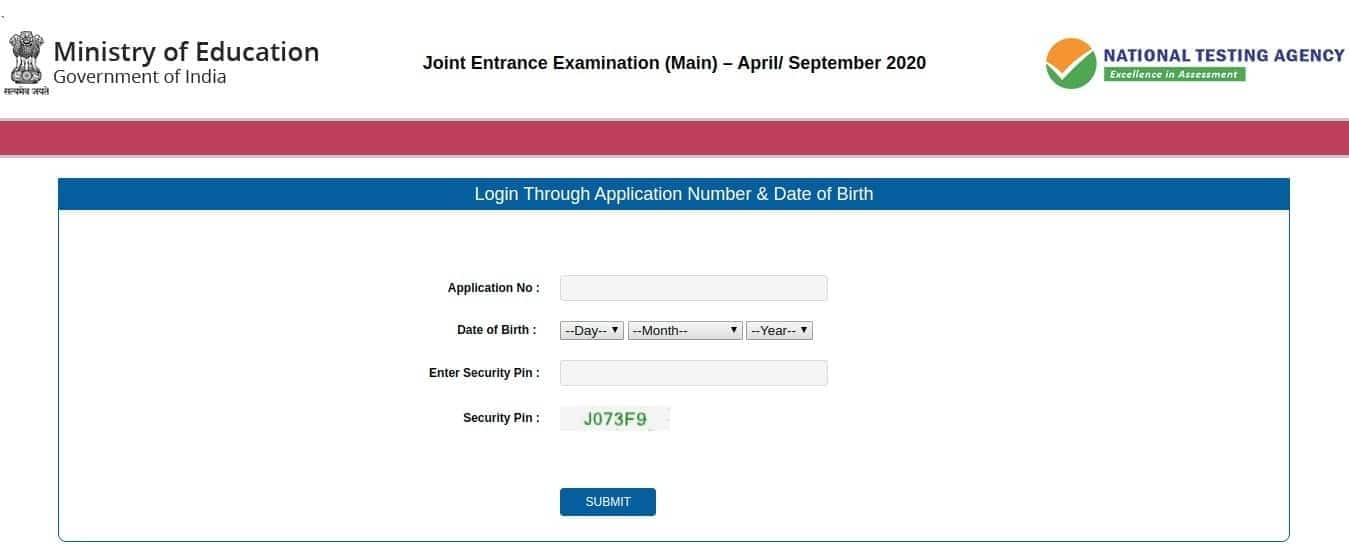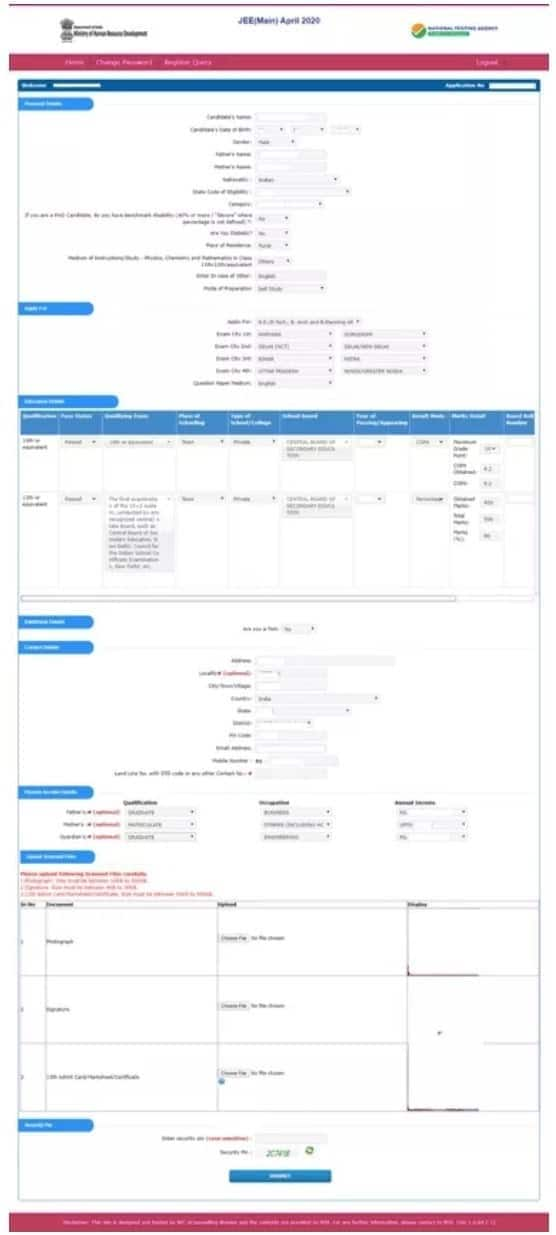Amrita University B.Tech 2026
Recognized as Institute of Eminence by Govt. of India | NAAC ‘A++’ Grade | Upto 75% Scholarships
JEE Main Application Form Correction 2026 - NTA has closed the JEE Main 2026 form correction window on December 2, 2025. The JEE Main application form correction 2026 link was activated on the official website, jeemain.nta.nic.in. Candidates had to log in using their application number and password to correct the JEE Main 2026 application form. This year, the authority allowed applicants to edit their identity details (if not chosen Aadhaar) and the State Code of Eligibility as well. The Joint Entrance Examination Main for sessions 1 and 2 is scheduled to be held between January 21 and 30 and April 2 and 9, 2026. Check this article for what details can be edited and what not during the NTA JEE Mains form correction 2026 process.
Candidates aiming for JEE Mains 2026 for admission to BTech programmes at various engineering colleges can check the syllabus for BTech paper 1 from the table given below.
Physics | Chemistry | Mathematics |
|
|
|
This Story also Contains

The authority will issue the city allotment slip and JEE Mains admit card to those whose application forms are accepted. Candidates are advised to check the JEE Main 2026 eligibility criteria before applying. Find below more details on the JEE Main 2026 here.
The National Testing Agency announced the JEE Main application form 2026 correction date for session 1 on the official website. The JEE Main 2026 correction concluded on December 2, 2025. Candidates can check the dates for JEE Main 2026 form correction in the table below.
Events | Dates |
Release of JEE Main 2026 application form | Session 1: October 31, 2025 Session 2: Last week of January 2026 |
JEE Mains 2026 application form last date | Session 1: November 27, 2025 Session 2: February 2026 |
JEE Mains 2026 form correction release date | Session 1: December 1, 2025 Session 2: February 2026 |
JEE Main form correction 2026 last date | Session 1: December 2, 2025 Session 2: February 2026 |
JEE Main 2026 exam date | Session 1: January 21 to 30, 2026 Session 2: April 2 to 09, 2026 |
The session 1 JEE Main 2026 application correction window was active between December 1 to 2, 2026. Candidates were able to edit their JEE application form at jeemain.nta.nic.in 2026. Aspirants can check the details that can be corrected below.
Name change of the candidate or Father's or Mother's: Candidates can either change their name, their father's name or their mother's name (any one only).
Category: Candidates can either change their category or re-upload their category certificate and vice versa, but not both.
Sub-Category: Candidates can either change their sub-category (PwD) or re-upload their sub-category certificate and vice versa but not both.
City and Medium: Candidates are allowed to change their city preferences along with the medium in which they want to take the JEE Main 2026 exam.
Qualification including passing year - Class 10th and 12th: Candidates can also make necessary amendments in the qualification details in the 10th and 12th or equivalent passing examination.
Course: NTA will allow the candidates to add papers to appear for in the JEE Main.
State Code of Eligibility: Applicants can change their state code of eligibility.
Date of Birth: Students can change their date of birth.
Gender: Candidates can change their gender.
Signature: Applicants are allowed to change their signature uploaded while filling out the JEE Main application form.
Identity Details: If the candidate's chosen Identity is other than Aadhaar, they can change their details.
The JEE Main application correction fee is applicable for certain modifications. Candidates seeking specific changes are advised to note the following scenarios that require an extra charge:
Changing Category: If a candidate wishes to change their category from SC/ST/Girls/PwD to General/OBC-NCL, an additional fee will be applicable.
Opting for Multiple Papers: If a candidate decides to opt for two or more papers instead of a single paper, an extra fee will be required for the additional papers.
Changing Exam City Preference: If a candidate wishes to modify their exam city preference to a foreign city, an additional fee will be levied for this change.
Colleges Accepting JEE Main Scores | |
The authority had activated the JEE Main correction window 2026 for sessions 1 on the official website, jeemain.nta.nic.in. To avail the JEE Main correction 2026 facility, candidates were required to log in using their registration number and password. The step-by-step guide for the JEE Main correction form 2026 is mentioned below for reference purposes.
Step 1- Open the JEE Main 2026 official website and log in using your registration number and password.

Step 2- After logging in, “JEE Main Correction in Application Form 2026 link” and proceed to make corrections.
Step 3- Read the instructions and click on Proceed for the JEE Main correction window 2026.
Step 4- Students will see the detailed application form. Make the necessary corrections if required.

Step 5- After making all the corrections, click on the “Submit” link and pay the JEE Main correction fee.
Step 6- Take a printout of the application form after making corrections and keep it safe till the completion of the admission process.
Certain information in the JEE Main 2026 application form remained non-editable, such as the Mobile Number, Email Address, Permanent Address, Correspondence Address, Emergency contact details, and Photograph. Candidates had to ensure the accuracy of these details during the initial submission. It's essential to provide accurate and up-to-date contact and address information for communication purposes.
Candidates must note the following few important points regarding the JEE Main correction window 2026
JEE Main 2026 form registration will be active till November 27, 2026 (11:50 PM) for session 1.
Candidates providing incorrect/inappropriate information in their application form will be rejected/will not be considered for admission.
JEE Mains 2026 application form correction facility will be available separately for both phases. The correction window for JEE Mains 2026 will be opened on the official website.
Not all details are made open for modification during form correction. Details about information which can be modified are made available in the brochure.
Certain correction also requires paying fees, like the JEE Main category change for SC/ST to Gen/OBC-NCL
100% Placement Record | Highest CTC 54 LPA | NAAC A++ Accredited | Ranked #62 in India by NIRF Ranking 2025 | JEE & JET Scores Accepted
Among top 100 Universities Globally in the Times Higher Education (THE) Interdisciplinary Science Rankings 2026
The authorities will issue the admit card for the JEE Main 2026 session in January 2026. Candidates who submit the JEE Main 2026 application form within the registration window will be issued an admit card to appear in the exam. Details about the exam centre, date, and timing of the paper will be mentioned in the JEE Mains admit card 2026.
Frequently Asked Questions (FAQs)
The JEE Main 2026 application form correction window dates are December 1 to 2, 2025.
As per the updated JEE Main image specification, the photograph should be of 3.5 cm by 4.5 cm dimension while the size of the uploaded file has to be between 10 kb to 200 kb. The JEE Main signature size should be 3.5 cm by 1.5 cm while the file size should be between 10 kb to 100 kb.
Yes, candidates can change their personal details during the JEE Main 2026 application form correction.
The JEE Main 2026 application correction window was open on December 1st and remained active on December 2nd until 11:50 pm
Yes, candidates can make changes to their selected papers (Paper 1, Paper 2A, or Paper 2B) during the correction window. If a paper is added, an extra fee will be required, but the fee for any removed paper will not be refunded.
To change the candidate's name in the JEE Main application form, candidates need to log in to the correction portal during the designated correction period and follow the instructions provided by the conducting authority.
Yes, candidates can change their category for JEE Main 2026 during the JEE form correction process.
If parents' names are entered incorrectly in the JEE Mains application form, you can correct them during the correction period specified by the conducting authority through the designated correction portal.
To modify details in the application form of JEE Main, candidates have to access the correction portal using their login credentials and make the necessary changes according to the guidelines provided by the conducting authority.
During the JEE Main form correction, candidates can modify their personal details, educational details, exam city preferences and more.
On Question asked by student community
Hello,
Yes, you can clear the exam in one and a half month if you study with the right strategy. Many students have prepared in a short time and still scored well by focusing only on the most important chapters and practicing questions daily. You need to revise high weightage topics from all three subjects and solve previous year papers regularly. Give mock tests every two or three days to understand your weak areas. Keep your schedule simple and consistent. If you avoid distractions and focus only on scoring chapters, it is possible to clear the exam in this time.
Hope this helps you.
Hello,
Yes, JEE Main Previous Year Question Papers (PYQ) are available in Hindi medium.
Here you can access PYQ from mentioned link below:
https://engineering.careers360.com/hi/articles/jee-main-question-paper
Hope it helps.
Hello,
With around 30 marks in JEE Main, it will be difficult to get into NITs and IITs, but you may be able to get admission into some private colleges or state-level government colleges through state-quota seats. It's also recommended to check your state's engineering admission process.
I hope it will clear your query!!
Hello,
It is possible to prepare for the JEE session in a short time, but you will need a focused and realistic approach. Instead of trying to cover everything, concentrate on the important chapters and strengthen the topics you already know. Solve previous questions and take practice tests to improve speed and accuracy. Manage your time well and revise regularly. With consistent effort and smart preparation, you can still aim for a good performance even with limited time.
Hope this helps you.
Hello there,
Studying important topics is very essential. It will give you an advantage in examination specially in exams like JEE mains.
Here is the link attached from the official website of Careers360 which will give you the list of all the important topics from all the subjects of JEE mains that is Physics, Chemistry and math. Hope it helps!
https://engineering.careers360.com/articles/most-important-chapters-of-jee-main
thank you!
Among top 100 Universities Globally in the Times Higher Education (THE) Interdisciplinary Science Rankings 2026
Recognized as Institute of Eminence by Govt. of India | NAAC ‘A++’ Grade | Upto 75% Scholarships
Hands on Mentoring and Code Coaching | Cutting Edge Curriculum with Real World Application
Attempt JEE Main online mock test based on the updated syllabus. Check your preparation and identify your weak points.
Ranked #43 among Engineering colleges in India by NIRF | Highest Package 1.3 CR , 100% Placements
NAAC A++ Grade | Recognized as Category-1 Deemed to be University by UGC | 41,000 + Alumni Imprints Globally